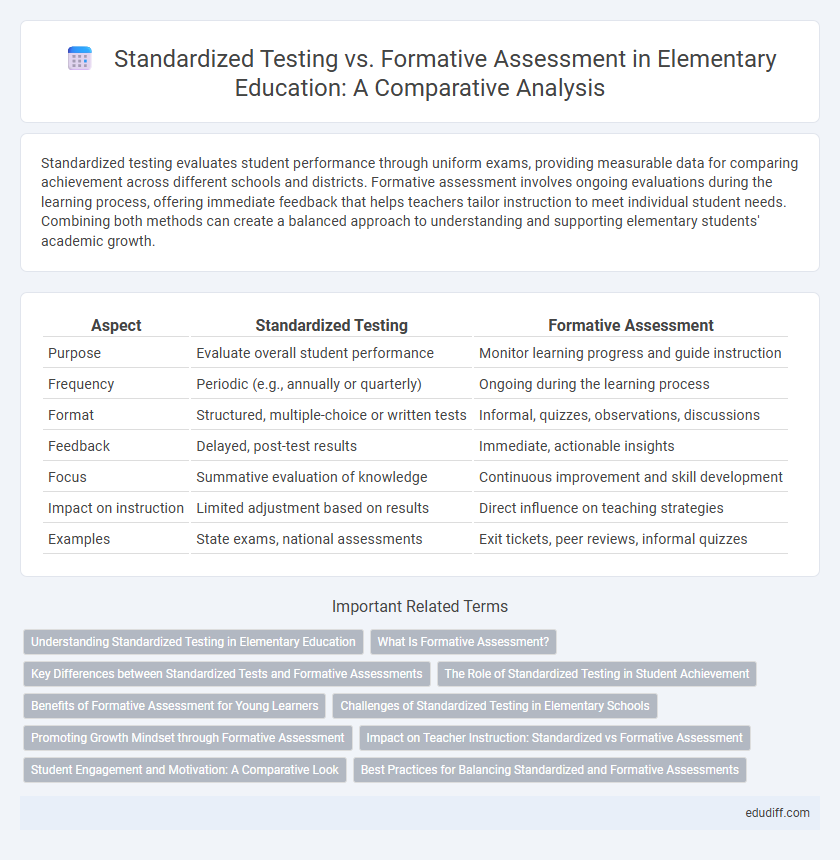Standardized testing evaluates student performance through uniform exams, providing measurable data for comparing achievement across different schools and districts. Formative assessment involves ongoing evaluations during the learning process, offering immediate feedback that helps teachers tailor instruction to meet individual student needs. Combining both methods can create a balanced approach to understanding and supporting elementary students' academic growth.
Table of Comparison
| Aspect | Standardized Testing | Formative Assessment |
|---|---|---|
| Purpose | Evaluate overall student performance | Monitor learning progress and guide instruction |
| Frequency | Periodic (e.g., annually or quarterly) | Ongoing during the learning process |
| Format | Structured, multiple-choice or written tests | Informal, quizzes, observations, discussions |
| Feedback | Delayed, post-test results | Immediate, actionable insights |
| Focus | Summative evaluation of knowledge | Continuous improvement and skill development |
| Impact on instruction | Limited adjustment based on results | Direct influence on teaching strategies |
| Examples | State exams, national assessments | Exit tickets, peer reviews, informal quizzes |
Understanding Standardized Testing in Elementary Education
Standardized testing in elementary education evaluates student performance using uniform procedures and scoring to measure proficiency across grade levels and subjects. These assessments provide quantifiable data to compare student achievement at local, state, and national levels, informing policy decisions and resource allocation. However, standardized tests may not fully capture individual learning progress or critical thinking skills essential for elementary students' development.
What Is Formative Assessment?
Formative assessment in elementary education involves ongoing evaluations that provide immediate feedback to guide student learning and instructional adjustments. It includes tools such as quizzes, observations, and class discussions designed to identify strengths and areas for improvement without grading pressure. This approach contrasts with standardized testing by fostering a supportive environment focused on growth and skill development throughout the learning process.
Key Differences between Standardized Tests and Formative Assessments
Standardized tests measure student performance through uniform questions and scoring, providing data that compares results across large groups. Formative assessments involve ongoing evaluations during the learning process, giving immediate feedback to guide instruction and support individual student growth. Key differences include the timing, purpose, and flexibility, with standardized tests being summative and fixed, while formative assessments are adaptive and diagnostic.
The Role of Standardized Testing in Student Achievement
Standardized testing provides a uniform measure to evaluate student achievement across different schools and districts, enabling comparison of performance data at local, state, and national levels. These tests help identify achievement gaps, inform policy decisions, and allocate resources more effectively to improve education quality. However, reliance on standardized testing alone may overlook individual student growth and diverse learning styles.
Benefits of Formative Assessment for Young Learners
Formative assessment promotes continuous feedback, allowing young learners to identify strengths and areas for improvement during the learning process. This approach supports personalized instruction tailored to each student's needs, enhancing engagement and understanding. It also encourages a growth mindset by emphasizing progress over performance, which is crucial for developing foundational skills in elementary students.
Challenges of Standardized Testing in Elementary Schools
Standardized testing in elementary schools often presents challenges including increased student stress and limited ability to capture individual learning progress. These tests primarily assess a narrow range of skills, overlooking critical areas such as creativity and social development. Teachers face difficulties adapting instruction to diverse student needs when relying heavily on standardized test results.
Promoting Growth Mindset through Formative Assessment
Formative assessment in elementary education supports a growth mindset by providing ongoing feedback that helps students understand their learning progress and areas needing improvement. Unlike standardized testing, which measures fixed achievement levels, formative assessments encourage students to view challenges as opportunities to develop skills through effort. This ongoing dialogue fosters resilience and motivates learners to embrace mistakes as part of the learning process.
Impact on Teacher Instruction: Standardized vs Formative Assessment
Standardized testing limits teacher instruction by focusing on broad content coverage and rigid timelines, which restricts adaptability in the classroom. Formative assessment provides ongoing feedback, enabling teachers to adjust lessons and target individual student needs for improved learning outcomes. Emphasizing formative assessment fosters a responsive teaching environment that supports personalized instruction and skill development.
Student Engagement and Motivation: A Comparative Look
Standardized testing often limits student engagement by emphasizing memorization and high-stakes outcomes, which can increase anxiety and reduce intrinsic motivation. In contrast, formative assessment fosters continuous feedback and active participation, promoting deeper learning and sustained motivation through personalized support. Research shows that students involved in formative assessment demonstrate higher engagement levels and improved academic confidence compared to those primarily assessed by standardized tests.
Best Practices for Balancing Standardized and Formative Assessments
Balancing standardized testing and formative assessments in elementary education requires integrating data-driven insights from standardized tests with ongoing formative feedback methods such as observations, quizzes, and student reflections. Best practices emphasize using standardized tests to identify broader learning trends while employing formative assessments to tailor instruction to individual student needs and promote deeper understanding. This balanced approach enhances student engagement, supports differentiated instruction, and improves overall academic outcomes.
Standardized Testing vs Formative Assessment Infographic

 edudiff.com
edudiff.com